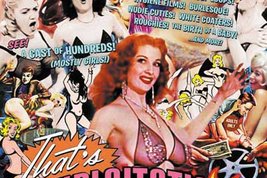Today, a few taps of the touch screen will unleash a torrent of T and A to anyone’s smartphone, but that wasn’t always the case.
From the 1920s-’60s, those interested in enjoying some onscreen concupiscence had to venture out to seedy arcades or grindhouse theaters.
Movie buffs curious to take a peek back at those times are in luck. “That’s Sexploitation!” is an evening of deviant documentaries celebrating the heyday of cheesy skin flicks. The screening takes place Sept. 13 at PhilaMOCA, 531 N. 12th St. Travis Crawford, the longtime programmer of Danger After Dark, will introduce the double feature, which begins with “That’s Sexploitation!” and is followed by “Let Me Die a Woman.”
Crawford cheerfully concedes that the majority of sexploitation films have little artistic merit, but that doesn’t mean contemporary audiences can’t learn something from them.
“Sexploitation films provide a window into a different time in American culture and also a different time in American sexual morality in a way that mainstream Hollywood films of any particular era — ’30s, ’40s, ’50s, whatever — really don’t,” Crawford said. “I think it’s hard to imagine people lining up around the block to see a birth-of-a-baby movie like ‘Mom and Dad.’ That’s kind of inconceivable by our standards.”
Fortunately, viewers don’t have to suffer through the miracle of childbirth, because director Frank Henenlotter’s paean to prurient pictures only presents the highlights. Clocking in at over two hours, “That’s Sexploitation!” includes dozens of clips from a dizzying variety of sleazy subgenres, including nudist-camp movies, sex-hygiene flicks, nudie cuties, smokers and roughies, all of which were produced to get straight men off.
Henenlotter, the impresario behind the horror-comedies “Basket Case” and “Frankenhooker,” occasionally steps in front of the camera to share his knowledge. But for the most part, viewers’ guide through this cinematic sewer is David Friedman.
Dressed in a cozy sweater and clutching a stogie, Friedman could be anyone’s zayde, but it turns out that this geriatric raconteur has firsthand knowledge of the subject. His career began with nudie cuties and graduated to roughies, films where the sex was accompanied by a generous helping of violence. He also knew many pioneers of the sexploitation genre.
During his apprenticeship, Friedman learned that sex sells, whatever its form. It was a lesson he never forgot as he churned out movies with titles like “She Freak” and “Pussy Galore.”
“The sexploiteer was not bound by any code,” Friedman said. “He was free to use any subject in the world, as long as it was in bad taste, and he did: dope, miscegenation, roadhouses, prostitution, child marriage, etc., etc. You name it.”
Friedman and his colleagues constantly tempted audiences, and censors, by pushing the limits. This led to some bizarre images: toy soldiers arrayed for battle across the bosom of a “sleeping” nymphet or an old-time burlesque performer dancing with pigeons perched across her shoulders and arms, to name just two. But even after they began showing pubic hair, the sexploitation films never showed actual intercourse.
As Henenlotter told Vice magazine in a prerelease interview, he deliberately avoided tackling hard-core pornography.
“Once it becomes porn, I lose all interest in it. I like the tease, I like almost getting there,” he said.
Consequently, he ends “That’s Sexploitation!” at the beginning of the 1970s, when a new breed of sex cinema captured the attention of audiences. Still, the movie is a thoughtful, affectionate look at a profitable film industry that flourished in Hollywood’s shadow for decades.
The evening’s second feature, “Let Me Die a Woman,” was released in 1977, a few years after porn had elbowed Friedman and other sexploiteers out of the market. It differs from the movies Henenlotter examines in a significant way: Its director was one of the few women in what was, essentially, an old boys’ club.
Doris Wishman was already middle-aged when she entered the sexploitation racket. That was shortly after her husband passed away, and her primary goal was to make money. By all accounts, she was an inept director, and she was ambivalent at best about sexuality.
Billed as a documentary about men and women who were, at that time, labeled transsexuals, Wishman’s film is actually an awkward amalgamation of interviews, stock footage, cheesy porn “reenactments” and gory clinical instruction films.
Crawford selected the film, in part, to give audiences a glimpse of the gritty, shocking side of sexploitation. As he points out, however, even this borderline-offensive movie has its redeeming moments, largely thanks to a transgender woman named Leslie.
“I’ve got to give Wishman that much credit,” Crawford said. “She really knew what the strength of the movie was and it was with this woman Leslie as an interview subject, because she’s candid, she’s very self-aware and she’s hilariously funny. She tells a couple of stories that steal the movie.” n
Crawford hopes that contemporary audiences, especially transgender viewers, will approach Wishman’s documentary with greater understanding and sympathy than those who originally saw it in sleazy theaters on New York City’s 42nd Street.
“I think that the transgender community has been around long enough that I hope they can now view films like this in the way gay audiences came to view less politically correct, more insensitive films that at the time were subjects of outrage, something like Friedkin’s ‘Cruising,’ for example. Now it’s an interesting artifact of a lost era.”
Film fans eager to abuse their eyeballs can find more information at www.philamoca.org.
